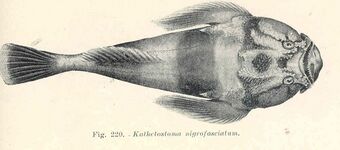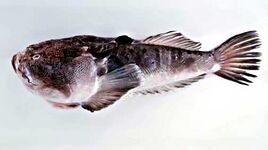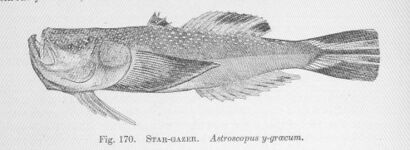Biology:Stargazer (fish)
| Stargazer | |
|---|---|

| |
| Common stargazer, Kathetostoma laeve | |
| Scientific classification | |
| Domain: | Eukaryota |
| Kingdom: | Animalia |
| Phylum: | Chordata |
| Class: | Actinopterygii |
| Order: | Trachiniformes |
| Family: | Uranoscopidae Jordan & Evermann, 1898 |
| Genera | |
|
See text | |
The stargazers are a family, Uranoscopidae, of perciform fish that have eyes on top of their heads (hence the name). The family includes about 51 species (one extinct) in eight genera, all marine and found worldwide in shallow and deep saltwaters.[1]
Description
In addition to the top-mounted eyes, a stargazer also has a large, upward-facing mouth in a large head. Their usual habit is to bury themselves in sand, and leap upwards to ambush prey (benthic fish and invertebrates) that pass overhead. Some species have a worm-shaped lure growing out of the floors of their mouths, which they can wiggle to attract prey's attention. Both the dorsal and anal fins are relatively long; some lack dorsal spines. Lengths range from 18 up to 90 cm, for the giant stargazer Kathetostoma giganteum.
Stargazers are venomous; they have two large venomous spines situated behind their opercles and above their pectoral fins. The species within the genera Astroscopus and Uranoscopus can also cause electric shocks. Astroscopus species have a single electric organ consisting of modified eye muscles, while Uranoscopus species have theirs derived from sonic muscles.[2] These two genera within stargazers represent one of eight independent evolutions of bioelectrogenesis.[2] They are unique among electric fish in not possessing electroreceptors, meaning that they do not use an electric sense to locate prey.[2]

Stargazers are a delicacy in some cultures (the venom is not poisonous when eaten), and they can be found for sale in some fish markets with the electric organ removed. Stargazers are ambush predators which camouflage themselves; some can deliver both venom and electric shocks. Ichthyologist William Leo Smith called them "the meanest things in creation".[4]
Genera
Uranscopidae contains the following genera: [5]
- Xenocephalus Uranoscopus
- Kathetostoma Astroscopus
- Brevoort, 1860 Gill, 1861
- Günther, 1860 Kaup, 1858
- Pleuroscopus Ichthyscopus
- Barnard, 1927 Linnaeus, 1758
- Genyagnus Swainson, 1839
- Okamura & Kishimoto, 1993 Selenoscopus
-
Deepwater stargazer
(Kathetostoma nigrofasciatum) -
Northern stargazer
(Astroscopus guttatus) -
Whitemargin stargazer
(Uranoscopus sulphureus) -
Southern stargazer
(Astroscopus y-graecum)
Timeline
<timeline> ImageSize = width:1000px height:auto barincrement:15px PlotArea = left:10px bottom:50px top:10px right:10px
Period = from:-65.5 till:10 TimeAxis = orientation:horizontal ScaleMajor = unit:year increment:5 start:-65.5 ScaleMinor = unit:year increment:1 start:-65.5 TimeAxis = orientation:hor AlignBars = justify
Colors =
#legends id:CAR value:claret id:ANK value:rgb(0.4,0.3,0.196) id:HER value:teal id:HAD value:green id:OMN value:blue id:black value:black id:white value:white id:cenozoic value:rgb(0.54,0.54,0.258) id:paleogene value:rgb(0.99,0.6,0.32) id:paleocene value:rgb(0.99,0.65,0.37) id:eocene value:rgb(0.99,0.71,0.42) id:oligocene value:rgb(0.99,0.75,0.48) id:neogene value:rgb(0.999999,0.9,0.1) id:miocene value:rgb(0.999999,0.999999,0) id:pliocene value:rgb(0.97,0.98,0.68) id:quaternary value:rgb(0.98,0.98,0.5) id:pleistocene value:rgb(0.999999,0.95,0.68) id:holocene value:rgb(0.999,0.95,0.88)
BarData=
bar:eratop bar:space bar:periodtop bar:space bar:NAM1
bar:space bar:period bar:space bar:era
PlotData=
align:center textcolor:black fontsize:M mark:(line,black) width:25 shift:(7,-4) bar:periodtop from: -65.5 till: -55.8 color:paleocene text:Paleocene from: -55.8 till: -33.9 color:eocene text:Eocene from: -33.9 till: -23.03 color:oligocene text:Oligocene from: -23.03 till: -5.332 color:miocene text:Miocene from: -5.332 till: -2.588 color:pliocene text:Plio. from: -2.588 till: -0.0117 color:pleistocene text:Pleist. from: -0.0117 till: 0 color:holocene text:H.
bar:eratop from: -65.5 till: -23.03 color:paleogene text:Paleogene from: -23.03 till: -2.588 color:neogene text:Neogene from: -2.588 till: 0 color:quaternary text:Q.
PlotData=
align:left fontsize:M mark:(line,white) width:5 anchor:till align:left
color:eocene bar:NAM1 from: -11.6 till: 0 text: Astroscopus
PlotData=
align:center textcolor:black fontsize:M mark:(line,black) width:25
bar:period from: -65.5 till: -55.8 color:paleocene text:Paleocene from: -55.8 till: -33.9 color:eocene text:Eocene from: -33.9 till: -23.03 color:oligocene text:Oligocene from: -23.03 till: -5.332 color:miocene text:Miocene from: -5.332 till: -2.588 color:pliocene text:Plio. from: -2.588 till: -0.0117 color:pleistocene text:Pleist. from: -0.0117 till: 0 color:holocene text:H.
bar:era from: -65.5 till: -23.03 color:paleogene text:Paleogene from: -23.03 till: -2.588 color:neogene text:Neogene from: -2.588 till: 0 color:quaternary text:Q.
</timeline>
References
- ↑ Bray, Dianne. "Family Uranoscopidae". http://www.fishesofaustralia.net.au/home/family/82. Retrieved 30 September 2014.
- ↑ 2.0 2.1 2.2 2.3 Alves-Gomes, J. A. (2001). "The evolution of electroreception and bioelectrogenesis in teleost fish: a phylogenetic perspective". Journal of Fish Biology 58 (6): 1489–1511. doi:10.1006/jfbi.2001.1625.
- ↑ Berry, Frederick H.; Anderson, William W. (1961). "Stargazer fishes from the western north Atlantic (Family Uranoscopidae)". Proceedings of the United States National Museum 1961. https://repository.si.edu/bitstream/handle/10088/16829/1/USNMP-112_3448_1961.pdf.
- ↑ Grady, Denise (22 August 2006). "Venom Runs Thick in Fish Families, Researchers Learn". The New York Times. https://www.nytimes.com/2006/08/22/science/22fish.html?ei=5094&en=3d2f666379306107&hp=&ex=1156219200&partner=homepage&pagewanted=print.
- ↑ Froese, Rainer, and Daniel Pauly, eds. (2022). "Uranscopidae" in FishBase. June 2022 version.
Further reading
- Gomon, M.F.; Roberts, C.D. (2011). "A second New Zealand species of the stargazer genus Kathetostoma (Trachinoidei: Uranoscopidae)". Zootaxa 2776: 1–12. doi:10.11646/zootaxa.2776.1.1.
Wikidata ☰ Q183280 entry
 |





